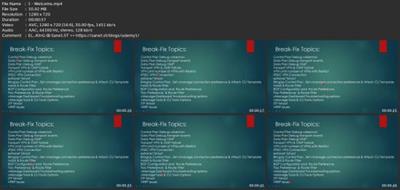M
0

Abc Of Cisco Sdwan Viptela Part 03 - Troubleshooting
Last updated 4/2019
MP4 | Video: h264, 1280x720 | Audio: AAC, 44.1 KHz
Language: English | Size: 2.35 GB | Duration: 4h 33m
Ratnesh K 2xCCIE #61380 (DC|Security)
Last updated 4/2019
MP4 | Video: h264, 1280x720 | Audio: AAC, 44.1 KHz
Language: English | Size: 2.35 GB | Duration: 4h 33m
Ratnesh K 2xCCIE #61380 (DC|Security)
What you'll learn
Anyone Who Wants to know the troubleshooting about CISCO SDWAN VIPTELA , but better suited to network engineers, Solution Architect and Managers.
Requirements
Networking Background required
Description
What is SD-WAN ? Software-Defined WAN (SD-WAN) is an overlay architecture that overcomes the biggest drawbacks of traditional WAN. SD-WAN builds a secure, unified connectivity over any transport (MPLS, Broadband, LTE, VSAT etc.) and provides simplified operations with centralized management, policy control and application visibility across the enterprise.STEPS TO TROUBLESHOOT Step 1 When analyzing a network problem, make a clear problem statement. You should define the problem in terms of a set of symptoms and potential causes.To properly analyze the problem, identify the general symptoms and then ascertain what kinds of problems (causes) could result in these symptoms. For example, hosts might not be responding to service requests from clients (a symptom). Possible causes might include a misconfigured host, bad interface cards, or missing router configuration commands.Step 2 Gather the facts that you need to help isolate possible causes.Ask questions of affected users, network administrators, managers, and other key people. Collect information from sources such as network management systems, protocol analyzer traces, output from router diagnostic commands, or software release notes.Step 3 Consider possible problems based on the facts that you gathered. Using the facts, you can eliminate some of the potential problems from your list.Depending on the data, for example, you might be able to eliminate hardware as a problem so that you can focus on software problems. At every opportunity, try to narrow the number of potential problems so that you can create an efficient plan of action.Step 4 Create an action plan based on the remaining potential problems. Begin with the most likely problem, and devise a plan in which only one variable is manipulated.Changing only one variable at a time enables you to reproduce a given solution to a specific problem. If you alter more than one variable simultaneously, you might solve the problem, but identifying the specific change that eliminated the symptom becomes far more difficult and will not help you solve the same problem if it occurs in the future.Step 5 Implement the action plan, performing each step carefully while testing to see whether the symptom disappears.Step 6 Whenever you change a variable, be sure to gather results. Generally, you should use the same method of gathering facts that you used in Step 2 (that is, working with the key people affected, in conjunction with utilizing your diagnostic tools).Step 7 Analyze the results to determine whether the problem has been resolved. If it has, then the process is complete.Step 8 If the problem has not been resolved, you must create an action plan based on the next most likely problem in your list. Return to Step 4, change one variable at a time, and repeat the process until the problem is solved.
Overview
Section 1: Introduction
Lecture 1 Welcome
Section 2: Data Plan Control Plan & VPN Troubleshooting
Lecture 2 Control Plan Debug vdaemon
Lecture 3 Data Plan Debug transport events
Lecture 4 Data Plan Debug OMP
Lecture 5 Tranport VPN & OMP Failure
Lecture 6 VPN Limit number of VPNs with Restrict
Section 3: Policies Template & BGP Troubleshooting
Lecture 7 IPSEC VPN Connection
Lecture 8 Extranet Tshoot
Lecture 9 BringUp Control Plan , Set vmanage connection preference & Attach CLI Template
Lecture 10 Install & Route Filter
Lecture 11 BGP Configuration and Route Preference 01
Lecture 12 BGP Configuration and Route Preference 02
Section 4: ZTP TLOC vManange & VRRP Troubleshooting
Lecture 13 Tloc Preference & Route Filter
Lecture 14 vManage Dashboard Troubleshooting options
Lecture 15 vManage Tools & CLI Tools Options
Lecture 16 ZTP tshoot Part 01
Lecture 17 ZTP tshoot Part 02
Lecture 18 VRRP Issues
Network Engineers

Download link
rapidgator.net:
You must reply in thread to view hidden text.
uploadgig.com:
You must reply in thread to view hidden text.
nitroflare.com:
You must reply in thread to view hidden text.
1dl.net:
You must reply in thread to view hidden text.

